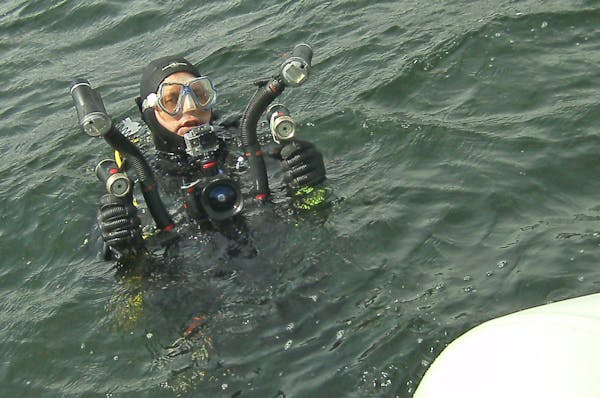They've searched the remains of an 18th-century frigate off the Florida coast and explored the Oahu waters that encompass the sunken U.S.S. Arizona. So you wouldn't think that the underwater crew scouting the St. Croix River for old wing dams last week would find the job exciting or even terribly interesting.
Wrong, said Jessica Keller of the National Park Service's Submerged Resources Center.
"Other places like Biscayne or other large national parks that we work at are ocean-based — it doesn't really change that much," she said. "This is quite dynamic. But it's also beautiful."
For much of June, members of the Denver-based diving team — along with the park service's Midwest Archaeological Center — have been hunting and mapping the federally-protected St. Croix National Scenic Riverway south of St. Croix Falls, Wis., for wing dams built a century ago by the U.S. Army Corps of Engineers.
The dams, fashioned below the water surface with angled logs resembling jagged rows of shark teeth, are barriers that extend only partly into the river. They were designed to force the current into the river's center to naturally develop a 3-foot-deep channel to accommodate steamboats carrying passengers and goods.
The project has two goals, said park historian Jean Schaeppi-Anderson: to find out what still exists and document it, and determine whether surviving dams are worth adding to the National Register of Historic Places.
"Once we have Jessica's report with all her information and the research we've put together," Schaeppi-Anderson said, "we'll go to the state historic preservation offices for the two states and say, 'What do you think? Is this something that should be preserved?' "
Information collected on the wing dams also will serve a practical purpose, Keller said, by helping paddlers steer clear of them.
The project, costing an estimated $20,000, is being paid for with mitigation funding built into the $676 million St. Croix River Bridge under construction south of Stillwater. The National Park Service received $250,000 from the bridge project for archaeological surveys, historic research and restroom facilities along the river; another $100,000 is going to the park service to develop a response plan for spills from the bridge.
On a recent sunny Friday, the team was preparing to don wet suits to map a rock-built closing dam at Log House Landing on the Minnesota side, and then head to Marine on St. Croix to inspect a wing dam.
Keller, juggling a sheaf of aerial river photos, explained that while most wing dams on the Mississippi River are covered in concrete, on the St. Croix they were mostly left alone when the river became recreational.
"We've done a lot of dam studies," she said, laughing at her phrasing, "but not specifically here on this river. These wing dams are unique. It's an interesting look into the past and what people did."
According to Schaeppi-Anderson, the Army Corps built wing dams on the St. Croix between 1881 and 1917, closing off islands and backwaters to steer the current into the main channel.
Workers cut down trees along the shore, formed layers of logs and brush and then used rocks to keep the dams in place. Much of the work was done in winter, when they could walk on the frozen river.
Over time, some wing dams were destroyed by log drives, ice or flooding, and others disappeared beneath layers of river silt. When low water in 2007 revealed several dams poking above the surface, Schaeppi-Anderson began searching for information on them. There wasn't a lot, but some sketches and a 1937 Army Corps map locating a few of them were found.
By mid-June, the park service team had finished a sonar scan survey of wing dam sites and moved on to the documentation phase, mapping a wing dam site near Franconia Landing north of Osceola, Wis. They had discovered no wrecks, let alone pirate's treasure or sea monsters, Keller said.
"We've found a lot of cans and trash," she said. "There's a lot of monofilament [fishing] line, actually. I got hooked with an old hook and line and was trapped for a minute."
Some have suggested that the wing dams, not being natural, should be torn out of the river rather than preserved. But Chris Stein, the park's superintendent, said the St. Croix has been significantly modified even though it looks natural. The wing dams are an important part of the river's story, he said.
"Some people will tell you a wing dam is nothing but a pain in the butt — it gets in my way, my pontoon will scrape on it," he said. "But Congress told us in the Wild and Scenic River Act that we're responsible for protecting the outstanding and remarkable values of the riverway. These things have intrinsic value just being there."
Kevin Duchschere • 651-925-5035

Fall or spring, it's Rochester Mayo's year in prep tennis

Minneapolis reaches $150k settlement with eyewitness of George Floyd's murder

Israel-Hamas war creates 'really fraught times' at Minn. colleges

Rare and fatal brain disease in two deer hunters heightens concerns about CWD

